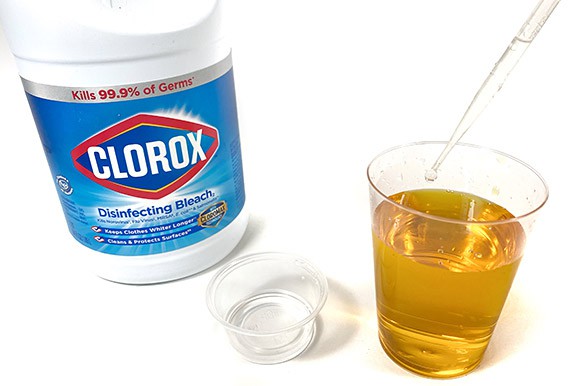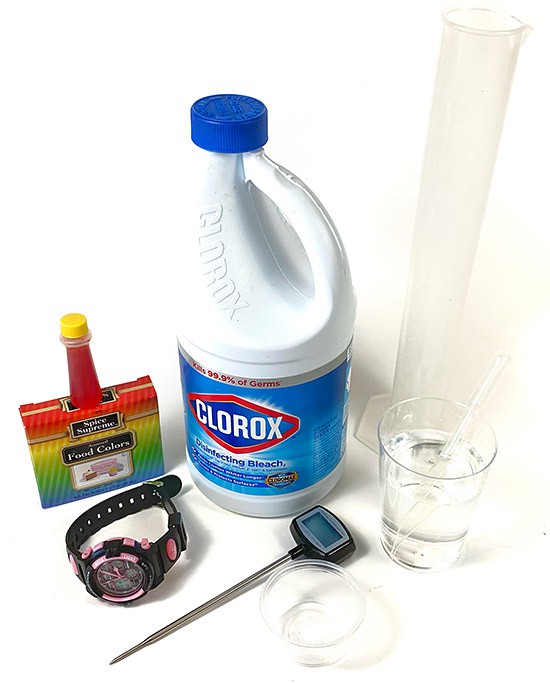Reaction Rates: Speed It Up with Temperature!
Summary

Overview
Teach your students how temperature affects chemical reaction rates in this highly visual experiment! Students will investigate color change during the reaction of food color with bleach, and measure the reaction times for different reaction temperatures.Learning Objectives
- Understand how chemical reactions rates can be controlled and manipulated
- Analyze graphs illustrating the progress of a chemical reaction over time
- Determine chemical reaction rates based on data of empirical investigations
- Explain why chemical reactions are temperature dependent
NGSS Alignment
This lesson helps students prepare for these Next Generation Science Standards Performance Expectations:- HS-PS1-5. Apply scientific principles and evidence to provide an explanation about the effects of changing the temperature or concentration of the reacting particles on the rate at which a reaction occurs.
|
Science & Engineering Practices
Planning and Carrying Out Investigations.
Make directional hypotheses that specify what happens to a dependent variable when an independent variable is manipulated.
Asking Questions and Defining Problems. Ask questions that can be investigated within the scope of the school laboratory, research facilities, or field (e.g., outdoor environment) with available resources and, when appropriate, frame a hypothesis based on a model or theory. Analyzing and Interpreting Data Analyze data using tools, technologies, and/or models (e.g., computational, mathematical) in order to make valid and reliable scientific claims or determine an optimal design solution. Constructing Explanations and Designing Solutions. Make a quantitative and/or qualitative claim regarding the relationship between dependent and independent variables. Apply scientific ideas, principles, and/or evidence to provide an explanation of phenomena. |
Disciplinary Core Ideas
PS1.B: Chemical Reactions.
Chemical processes, their rates, and whether or not energy is stored or released can be understood in terms of the collisions of molecules and the rearrangements of atoms into new molecules, with consequent changes in the sum of all bond energies in the set of molecules that are matched by changes in kinetic energy.
PS3.A: Definitions of Energy. These relationships are better understood at the microscopic scale, at which all of the different manifestations of energy can be modeled as a combination of energy associated with the motion of particles and energy associated with the configuration (relative position of the particles). In some cases the relative position energy can be thought of as stored in fields (which mediate interactions between particles). This last concept includes radiation, a phenomenon in which energy stored in fields moves across space. |
Crosscutting Concepts
Cause and Effect.
Changes in systems may have various causes that may not have equal effects.
Scale, Proportion, and Quantity. Algebraic thinking is used to examine scientific data and predict the effect of a change in one variable on another (e.g., linear growth vs. exponential growth). Stability and Change. Change and rates of change can be quantified and modeled over very short or very long periods of time. Some system changes are irreversible. |
Materials
 Image Credit: Svenja Lohner, Science Buddies / Science Buddies
Image Credit: Svenja Lohner, Science Buddies / Science Buddies
Materials per group of 2–4 students:
- 200 mL beaker or plastic cup
- Water (ice water, room temperature water and hot tap water)
- 3 mL graduated pipette
- 500 mL measuring cylinder
- 50 mL beaker (alternatively use a disposable 2 oz mini cup)
- Stopwatch
Materials that can be shared in the classroom:
- Food coloring (McCormick, Yellow #5) (1 vial, 0.3 oz, for approximately 4 groups)
- Bleach (8.25% hypochlorite)
- Thermometer for liquids
Background Information for Teachers
This section contains a quick review for teachers of the science and concepts covered in this lesson.Chemical reactions can happen either very fast, as in an explosion, or they can be really slow, such as the rusting of iron. Being able to control the speed of a reaction is crucial to many industrial processes. Studying chemical reaction rates allows students to investigate the factors that influence the speed of a reaction and explore reaction mechanisms in more detail. In this activity, students will study a chemical reaction that we use every time we apply bleach to our clothes: the bleaching of colored stains. A bleaching reaction, in which a colored compound becomes colorless, is ideal for studying reaction rates because the color change between the reactants and products can be easily monitored. The active ingredient in bleach, hypochlorite (OCl-), acts as an oxidant, which transforms the dye into a colorless molecule. The bleaching reaction can be summarized as:
Equation 1:Food colors, such as FD&C Blue #1 or Yellow #5 are large aromatic molecules that contain an extended conjugated system of alternating single and double bonds. This allows the absorption of light in the visible spectrum. This is why dyes appear colored to us. Once the molecular structure is altered, for example, through oxidation by bleach, the oxidized dye loses the ability to absorb light in the visible spectrum, rendering it colorless.
The reaction rate is a measure of how fast a chemical reaction proceeds and is expressed as a concentration change (of reactants or products) over time. Given that the food color disappears throughout the reaction, the reaction rate can be defined by the concentration change of the colored reactant over time, as stated in following rate law:
Equation 2:where Δ indicates "delta", or "change in", t is time [s], k is the rate constant [unit is dependent on the reaction order] for the reaction at room temperature, m and n indicate the reaction orders for the food dye and hypochlorite [unitless], respectively, and the squared brackets [ ] express the concentration of the reactant [mol/L or M].
Determining the reaction rate of the bleaching reaction requires measuring the dye concentration over time. This can be done visually by using the ability of the dye to absorb light. With more dye present in the solution, it gets darker and consequently absorbs more light. Once all dye has been oxidized, the solution will become colorless and the dye concentration can be assumed to be zero.
The collision theory states that for a chemical reaction to happen, the reactant molecules have to collide in the right orientation and with enough energy to react and form a product. This means that more collisions lead to a faster reaction. Many factors can influence the probability of reactant collisions, and therefore, determine the rate of a chemical reaction, including; 1) the temperature, 2) the concentration of the reactants, 3) the nature (and surface area) of the reactants, or 4) the presence/absence of a catalyst or an inhibitor. In this lesson plan, you will explore the effects of temperature only. A change in reaction temperature influences the reaction rate because a higher reaction temperature increases the average kinetic energy of the reacting molecules, which a) makes it more likely that they collide and react, and b) increases the proportion of reactant molecules that exceed the required activation energy of the reaction. In the rate law (Equation 2), this temperature dependency is reflected by the rate constant k which is temperature-dependent (as stated in the Arrhenius equation). As a rule of thumb, a reaction temperature increase of about 10 Kelvin (K) approximately doubles the reaction rate.
In this activity, students will conduct the bleaching reaction at three different temperatures in order to directly observe the effect of temperature on the reaction rate. They will use a stopwatch to time how long it takes for the food color to fade in each reaction. The results will allow students to determine the average reaction rate for each temperature.



